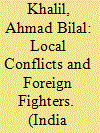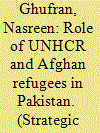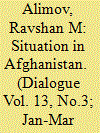| Srl | Item |
| 1 |
ID:
188810


|
|
|
|
|
| Summary/Abstract |
The emergence of the Afghan Arabs phenomena is the by-product of the Afghan ‘jihad’. The Arabs that mostly came to Afghanistan sought to fulfil a ‘religious’ duty in the form of jihad. This migration process from the Arab countries to the Af-Pak region was in line with the USA, Pakistan, Afghan mujahideen, Arab countries’ policies and volunteering fighters’ personal beliefs.
The Afghan Arabs were not a homogeneous group; they were ideologically and strategically fragmented and had different groups and views. Hence, all Afghan Arabs did not end up in Al-Qaeda. Despite this fragmentation, Afghan Arabs played an essential role in the Afghan conflict, from raising funds to providing volunteer fighters and coverage of ‘jihad’ through their media sources. They also intervened in the affairs of Afghan mujahideen groups. They either sided with the opposing jihadi factions (and later with the Taliban) during the Afghan Civil War or remained silent. In the post-2001 period, their role was limited to technical support and fighting against the ‘common enemy’. In this period, the Taliban’s policy towards Al-Qaeda was to not condemn, not cut ties, to regularise them while officially rejecting their presence.
|
|
|
|
|
|
|
|
|
|
|
|
|
|
|
|
| 2 |
ID:
101885


|
|
|
|
|
| Publication |
2011.
|
| Summary/Abstract |
Why has transnational war volunteering increased so dramatically in the Muslim world since 1980? Standard explanations, which emphasize U.S.-Saudi support for the 1980s Afghan mujahideen, the growth of Islamism, or the spread of Wahhabism are insufficient. The increase in transnational war volunteering is better explained as the product of a pan-Islamic identity movement that grew strong in the 1970s Arab world from elite competition among exiled Islamists in international Islamic organizations and Muslim regimes. Seeking political relevance and increased budgets, Hijaz-based international activists propagated an alarmist discourse about external threats to the Muslim nation and established a global network of Islamic charities. This "soft" pan-Islamic discourse and network enabled Arabs invested in the 1980s Afghanistan war to recruit fighters in the name of inter-Muslim solidarity. The Arab-Afghan mobilization in turn produced a foreign fighter movement that still exists today, as a phenomenon partly distinct from al-Qaida. The analysis relies on a new data set on foreign fighter mobilizations, rare sources in Arabic, and interviews with former activists.
|
|
|
|
|
|
|
|
|
|
|
|
|
|
|
|
| 3 |
ID:
107687


|
|
|
| 4 |
ID:
113603


|
|
|